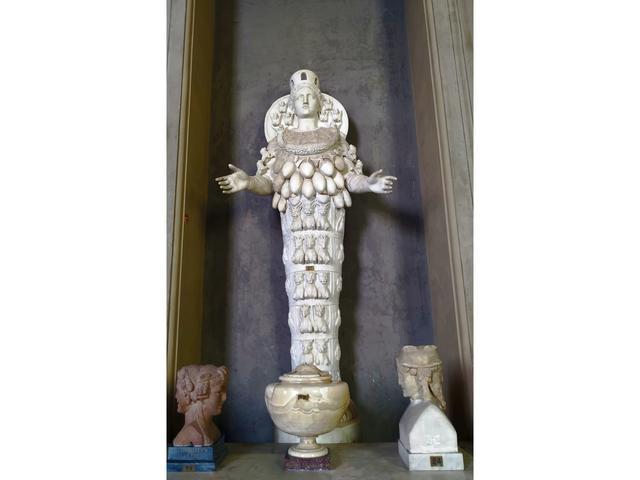Artemis of Ephesus

The Artemis of Ephesus, also known as the Diana of Ephesus, is a remarkable ancient sculpture that has captivated visitors to the Vatican Museums for centuries. This iconic statue was discovered in 1769 at Hadrian's Villa in Tivoli, before being acquired by the Vatican Museums in 1781. The statue is believed to be a Roman replica of a Greek original, dating back to the 5th century BC.
The Artemis of Ephesus is a representation of the goddess Artemis, who was worshipped in Ephesus, an ancient city in Asia Minor. Artemis was associated with nature, animals, fertility, and motherhood, and her cult was deeply rooted in the region. The statue's iconography reflects these aspects of the goddess, with intricate details such as the walls of Ephesus depicted as a crown, griffins adorning the sides, and a necklace featuring zodiacal elements.
One of the most intriguing features of the Artemis of Ephesus is the depiction of breasts in the central part of the statue. While traditionally interpreted as breasts, some studies suggest that they may actually represent bull testicles. This unusual interpretation is thought to be related to the goddess's festival, where bull testicles were worn around the neck as a necklace. This unique detail adds a layer of complexity to the statue's symbolism and highlights the rich cultural significance of Artemis in ancient times.
Visitors to the Vatican Museums can marvel at the Artemis of Ephesus and appreciate the craftsmanship and artistry of this ancient masterpiece. The statue's Greek-archaic features and intricate details offer a glimpse into the religious beliefs and artistic traditions of the ancient world. As one of the seven wonders of the ancient world, the Artemis of Ephesus continues to inspire awe and wonder in all who behold it, making it a must-see attraction for tourists and art enthusiasts alike.
© ChatGPT 3.5
Located in Ephesus, the Temple of Artemis was one of the Seven Wonders of the Ancient World.
The temple of Ephesus was destroyed by a fire caused by Erostratus on July 21, 356 BC. C the night that, it is said, Alexander the Great was born. According to history, his only goal was to achieve fame at any cost. Although it was rebuilt along the lines of the previous one, it ended up being razed by the Goths in the 3rd century AD.
Artemis, sister of Apollo, was worshiped in Ephesus in a pre-Hellenistic cult, representing fertility rather than virginity.
Inside this sanctuary was the statue of Artemis, a two-meter-high work of vine wood covered with silver and gold.
Pliny the Elder and Marcus Vitruvius claim that work continued for 120 years. and that there were several architects who directed them.
At the exit from Ephesus is the house of Mary, the Virgin, where she lived until her death in the company of the apostle John.